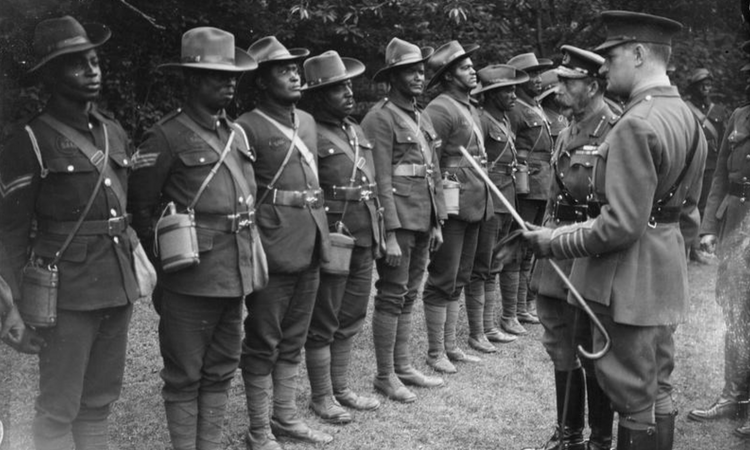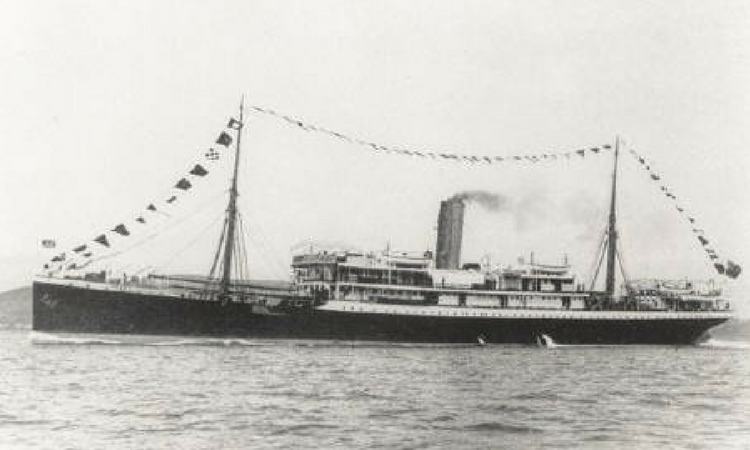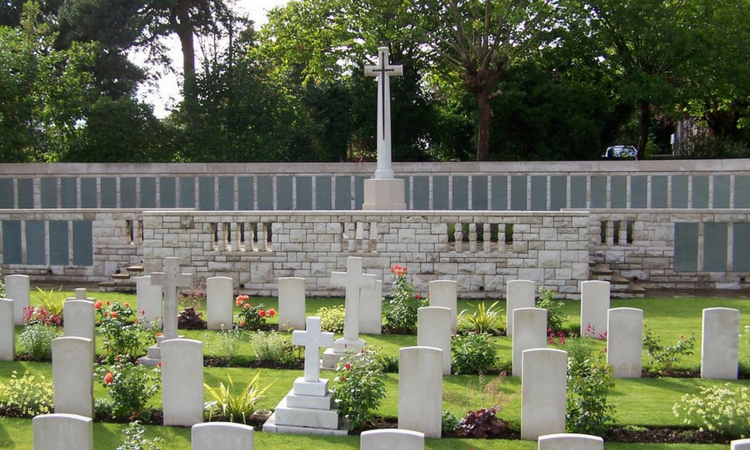21 February 2018
‘Let us die like brothers’ - Remembering the Mendi
Today, 21 February, marks 101 years since the sinking of the SS Mendi and is also South Africa’s Armed Forces Day. The sinking was one of the worst maritime disasters in British waters, and among the darkest moments of South Africa’s war. The number of lives lost was second only to the casualties suffered by the South African Brigade at Delville Wood during the Battle of the Somme in 1916.

King George inspecting NCO' s of the South African Native Labour Corps at Abbeville, 10 July 1917, © IWM (Q 5624)
South African forces in the First World War
When war was declared in 1914, South Africa, then a dominion of the British Empire, rallied immediately to the Allied cause.
South African troops fought in German South West Africa (Namibia) and in the campaign in East Africa (including modern Tanzania), as well as on the Western Front in France and Belgium, and many other significant battles including Arras, Passchendaele, and Mont Kemmel.
The South African Native Labour Corps (SANLC) made an important contribution to the war effort of the British Empire. Among them were respected warriors and tribal leaders, yet its personnel were not permitted to serve as combat troops, to carry weapons, or mix with white communities. A total of 25,000 South Africans joined the SANLC, of which 21,000 left South Africa for France.
The sinking of SS Mendi

The SS Mendi
The SS Mendi left Cape Town on 25 January 1917, carrying the last contingent of the SANLC bound for the Western Front – some 823 men.
On 19 February, the Mendi stopped in Plymouth before sailing for France the next day. She was escorted by the destroyer HMS Brisk.
The sea was calm, but after midnight thick fog surrounded the Mendi. She had to slow down until she was barely creeping forward. As German U-boats hunted in the area, slowing down was dangerous. By 4.57am the Mendi was 11 nautical miles (20 km) off the southern tip of the Isle of Wight.
Suddenly the steam ship SS Darro emerged from the dark and fog. The Darro was a mail ship, twice the size of the Mendi. Despite the conditions, the Darro was sailing at full speed and emitting no warning signals. She drove into the side of the Mendi amidships, cutting into the hold where men lay asleep.
The Mendi sank within 25 minutes. Almost 650 men, both crew and Labour Corps, died.
Reverend Isaac Wauchope Dyobha
Reverend Isaac Wauchope Dyobha was one of the men of the SANLC who died when the Mendi sank.
Eyewitness stories of the bravery exhibited by the men aboard the Mendi have become legendary. The most famous story perhaps is that of the death dance that the men performed as the ship went down. They were led by the chaplain, the Reverend Isaac Wauchope Dyobha, with the words “let us die like brothers”.
Commemorating the dead

CWGC Hollybrook Memorial in Southampton
On Saturday, a commemorative service organised by the South African Diaspora United will take place at the CWGC Hollybrook Memorial in Southampton.
The majority of the men who died on the Mendi have no known grave and are commemorated by name on the memorial, including Reverend Isaac Wauchope Dyobha.
The Commission commemorates more than 11,000 members of South African forces who died during the First World War.
CWGC Arques-la-Bataille British Cemetery in France contains the graves of nearly 400 servicemen of the First World War, many of whom were members of the South African Native Labour Corps (SANLC).
A memorial to all members of the SANLC who died in France was built at the centre of the cemetery. Inscribed on the stone, in English, Sesuto and Isixosa, are the words:
“To the memory of those Natives of the South African Labour Corps who crossed the seas in response to the call of their great Chief, King George V, and laid down their lives in France, for the British Empire, during the Great War 1914-1918, this Memorial is erected by their comrades.”

